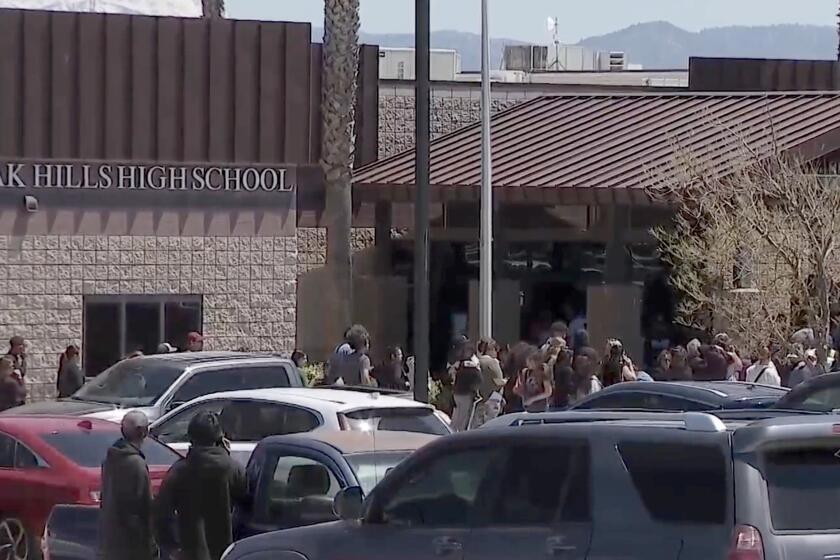Skid row’s PR problem
SUDDENLY, FINALLY, there’s some real money finding its way to the homeless.
The Los Angeles County Board of Supervisors -- the Five Little Kings -- has ponied up $80 million for the cause. The Bush administration, which has been busily creating homelessness in Baghdad, has put another billion or so into the home-front homeless kitty.
What’s missing? Advertising. The WD-40 of commerce, and philanthropy too. “A Mind Is a Terrible Thing to Waste.” “The Toughest Job You’ll Ever Love.” But the homeless are a harder sell than the United Negro College Fund or the Peace Corps.
The county has put $800,000 toward what it calls “the development and implementation of comprehensive community outreach and collaboration strategies to address anticipated averse community reaction to proposed new construction projects and services through a proactive approach, including the preparatory work of building relationships, collaborative alliances, judicious planning/action and education efforts.” PR, to you and me.
The way the county is spending that money acknowledges that the homeless aren’t just a downtown matter, and they’re no more homogeneous than, say, Whittier, a city about the size of the county’s homeless population of 88,000. It won’t be an easy sell. Five “stabilization centers” in different parts of the county will be an especially difficult sell, judging by reaction to the Union Rescue Mission’s plan to open a residence for homeless women and children near Sylmar; from the outcry, you’d think they were trying to set up a nudist camp for child molesters who work at nuclear waste dumps.
A PR campaign for the homeless could tip so wrong so many ways -- from lame to patronizing to evasive. I can’t see humor working either: “The Homeless: Not as Smelly as You Think.”
“We Are the World” comes close to true, but it’s been tried. Would yet another billboard of a ragged family, and a legend like “We were a couple of paychecks away from you,” make a dent in anybody’s attitude or help get another shelter built?
So I decided to ask the homeless: How would they make their own case?
James was at Third and Main, wearing a cap from a Chino sheet metal company. Maybe he once worked there; I couldn’t bring myself to ask. James wasn’t sure that PR would change anything: “Each individual is gonna think what he wants anyway. Just because you put [a billboard] up doesn’t mean it’ll do any good.”
On Spring Street, leaning against the iron fence next to the Ronald Reagan State Office Building, was Conrad. Unusual name, I said. “Like Joseph Conrad,” he said.
Surprised? Me too. Shame on me.
As Conrad thought about what the PR message should be, a fat guy with a shaved head walked by and made a disgusted-sounding noise. Conrad didn’t look at him. Finally, he said, “That we’re nice. That we want mutual respect. Honesty. Brotherhood.”
Help the homeless? Great. But help them to do what?
The intractable core of the chronically homeless has drawn the federal courts, cops, the ACLU and business people into a paper-scissors-rock game to find the pressure point of rights and care and lawlessness. The Lanterman-Petris-Short Act will turn 40 next year. It’s the revolutionary California law that emptied the state’s mental wards, fired the Nurse Ratcheds, trashed the Thorazine and gave mental patients a bill of rights, but not much else to guide them or the people they live among.
The people who draw just one or two of the short straws -- no work, no medical care, no home -- are easier to help. Families can be resettled, workers can be matched to jobs, even some mental problems can be treated. It’s the hard-core heart of the homeless, those with criminal records and addled senses as well, that seem beyond help, winding up classified as colorful urban fauna.
Al could be the poster boy for the best-case ad campaign. I met him on Fifth Street, “the nickel.” Sixty-nine years old, 14 years in the Army, who knows how many in a wheelchair. A genial character with a downtown hotel room to call home.
Not five minutes later, I watched a young man come out of a spiffed-up building, his two dogs straining at their leashes. He saw a homeless person’s packed cart out in traffic. “That’s someone’s life, right there,” he said, and pulled it back onto the sidewalk. Then a ranting homeless man rushed toward him, screaming obscenities and threats.
“Leave the homeless alone!” and “I’ll come over and grab that leash out of your hand. How would you like that?”
The man with the dogs moved off. “I love my space,” he said, “but not out here.” No amount of PR could convince anyone that that’s peaceful coexistence.
More to Read
Start your day right
Sign up for Essential California for news, features and recommendations from the L.A. Times and beyond in your inbox six days a week.
You may occasionally receive promotional content from the Los Angeles Times.







